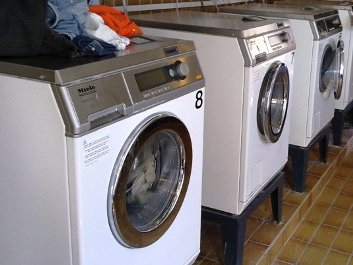 Except for the dryers being infamous for not performing their most basic task – drying –students at the Sogn Student Village near the University of Oslo were happy with how the laundry system worked. Just swipe your laundry card and run load, and the charges are conveniently billed along with the rent. Neat. But of course, all good things must come to an end.
Except for the dryers being infamous for not performing their most basic task – drying –students at the Sogn Student Village near the University of Oslo were happy with how the laundry system worked. Just swipe your laundry card and run load, and the charges are conveniently billed along with the rent. Neat. But of course, all good things must come to an end.
The university had decided to spend roughly $14 million on a new accounting/payment system. The large company responsible for this system shall remain unnamed, but the new system turned out to be an array of Seriously Annoying Programs. Amongst its effects, such as delayed salaries, was the fact that it couldn’t communicate with the laundry system. Unknown to most of the inhabitants of the student village, dark times were looming.
The first signs of change were the glass cabinets containing routers and the CAT5 cables being connected to each machine appearing in the laundries. Shortly thereafter, letters containing instructions for the new system were sent to all the inhabitants. Sadly, intention and reality were quite far apart in these letters:
Step One: Your Laundry Account
It seemed simple: go to your nearest laundry, insert your card, and a receipt with your username and password will be printed. Sure, one might react to the fact that you need a username and a password in order to do your laundry, but the company responsible was building a system for the new Miele-nnium. Of course it didn’t take too long for the small box printing receipts to run out of paper. And that packs of hapless and soon-to-become smelly students couldn’t do laundry, because how can one do laundry without any paper receipts?
Step Two: Login Fails
For the few lucky who were able to get a username and a password, the next step was to log in to a web-based system in order to prepay for using the laundry. For the user’s convenience, the username consisted of 20 uppercase letters and was case sensitive, looking somewhat like this: ASIHATETHISSYSTEMFH.
We should really give credit to the developers for thinking scalability, as a 20 character username will handle 10^28 users. Which is also about 10^18 times the number of humans on earth. Logging in, of course, failed for many users because 0's, O's, 1's and l's were indistinguashable.
Step Three: Install the Required Updates
As the login problems spread frustration among the poor inhabitants, the university was helpful enough to compile a how-to guide for logging in. As with other systems of such brilliance, it only worked in Internet Explorer. In addition, the helpful guide showed you how easy it was to install the required updates/patches on your computer needed to do your laundry. Slowly, the inhabitants were able to access their laundry accounts, except of course for Mac/Linux users who now could be recognized by the swarm of flies surrounding them.
Step Four: 8.333333 Machines, Please
As the web-based personal laundry administration system revealed itself to its users for the first time, relief spread among the inhabitants. It was simple enough. Fill your account with a certain amount of money using your credit card, then wash. Naturally, the pre-defined amounts you could choose from was not dividable by the cost of a single machine use, leaving many to wonder how to spend the last .333333 washes. The natural solution to this problem was of course to include a payback system into the web administration application, so that the inhabitants could get their remaining $0.566772 transferred back to their bank accounts. Neat.
Step 5: Reservations: Blocking the Machines for those who Need it
The web-based system had a neat feature: you could reserve a machine for a certain time (though washing without a reservation was still possible). Neat? Not at all, and some simple math explains it.
Let’s say a machine takes 1 hour, and I reserve it from 12:00. This means that after 11:01 nobody could start a new machine, as it would crash with my reservation. On average, this would cause a half hour idle period for each reservation, or a 50% drop in efficiency. This of course assumes that you actually use your reservation. If not, you simply blocked the machine for an hour or two for those who needed it.
Step 6: Profit?
To this day, the poor inhabitants of Sogn Student Village are still stuck with the nightmarish system. Some new habits have evolved, such as learning how to renew the washing machines’ IP addresses by disconnecting and connecting the network cable whenever there is a “network error” on the machines’ displays. In addition, organized protest groups have put up posters around the village complaining about the system.
Organized protest groups are generally considered a sign of bad usability, but I guess there’s a limit to how much you can expect from a $14 million system. And of course, the dryers still don’t dry.

